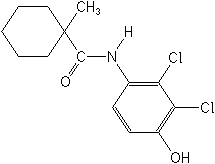-
Common NameFenhexamid
-
中文通用名环酰菌胺
-
IUPAC2′,3′-dichloro-4′-hydroxy-1-methylcyclohexanecarboxanilide
-
CASN-(2,3-dichloro-4-hydroxyphenyl)-1-methylcyclohexanecarboxamide
-
CAS No.126833-17-8
-
Molecular FormulaC14H17Cl2NO2
-
Molecular Structure
-
Category
-
ActivityFenhexamid is a protectant fungicide for foliar applications. Following application, the product penetrates the cuticle but only limited translocation takes place within the plant. Fenhexamid inhibits germ tube elongation and mycelial growth, and affects the formation of appressoria. The mechanism of action of the compound has been identified as sterol biosynthesis inhibition (SBI). Fenhexamid is the single representative of the hydroxyanilides class of SBIs: biochemical studies showed that fenhexamid does not, unlike other botryticides, inhibit cell nucleus division, mitochondrial activity or the synthesis of enzymes aiding host penetration. Fenhexamid differs in its action from other SBI fungicides such as Bayer's triadimenol (Baytan) and tebuconazole (Folicur) in that it disrupts sterol biosynthesis at two unique target steps in ergosterol biosynthesis, both catalysed by the C3-ketoreductase enzyme.
There has been no evidence of resistance development in Botrytis cinerea in programmes run for over a decade to test fenhexamid.
The product does not exhibit cross resistance to benzimidazoles, dicarboximides and anilinopyrimidines and can be used as a curative treatment if applied early in the disease life cycle. Fenhexamid is safe to target crops at all stages of their development. The product is normally applied in advance of infection (at bloom, post bloom) and can be applied until a few days (<3) before harvesting. Elevate can be applied four times per season to strawberries and grapes. A non-ionic surfactant (0.02% v/v) should be tank-mixed with this product for application to grapes only to increase the duration and level of disease control. Elevate is rainfast 6 hours after application. Strawberries treated just before harvest are protected against post-harvest Botrytis infections. Fenhexamid does not adversely affect the fermentation or organoleptic qualities of wines made from treated grapes, or flavour of the produce. A maximum of six applications of Decree per season to ornamentals is recommended.
In field trials reported by the Canadian PMRA, Elevate was demonstrated to provide a consistent increase in quality and yield of grapes at harvest. For strawberries, there was an increase in the quality of the fruit but not the yield. Similarly, there was an increase in quality when the product was used on ornamentals. There were no signs of phytotoxicity on use of the product.
Results from field trials and yield assesments conducted in the US, UK, Germany and other European countries show good control of B cinerea on caneberries, raspberries, blackberries, gooseberries, red and black currants upon application of fenhexamid (750-1000 g ai/ha) from early flower until harvest. Usage of the product in combination with tolylfluanid (using spray rotational programs or Talat, the pre-mixture combination of fenhexamid and tolylfluanid,D0061.2) offers good protection against B cinerea and other fungal diseases on berry crops. Fenhexamid was also tested as a post-harvest fungicide for use on pomegranates in California, where currently no fungicides are registered for post-harvest mould control. Dip treatment with fenhexamid reduced the incidence of grey mould decay, 2 and 5 months post-harvest, to 1.4% and 30.2% respectively as opposed to 69.4% and 97.4% in the control.
In field trials, fenhexamid gave similar or better control of Botrytis cinerea than standard treatments. It has shown no cross-resistance to other groups of botryticides. As one representative of new chemical groups, fenhexamid is particularly useful for resistance management programmes because it has both a novel mode of action and great flexibility in the timing of applications. The product is safe to beneficials and the company recommends its use in IPM schemes.
In addition to B cinerea, fenhexamid shows secondary effects on Monilia spp in stone fruit as well as Sclerotinia sclerotiorum, Gnomonia fruticola and Colletotrichum fragariae. -
CropUseCropUses:
almonds, apricots, blackberries, blackcurrants, blueberries, bushberries, caneberries, cherries, citrus, cucumbers, damsons, eggplant, elderberries, gooseberries, grapefruits, grapevines, huckleberries, Japanese plums, kiwifruits, legumes, lettuces, limes, loganberries, Mume plums, natsudaidai, nectarines, onions, ornamentals, paprika, peaches, pears, pistachios, plums, raspberries, red currants, soft fruits, stone fruits, strawberries, tomatoes, unushu oranges, vegetables, vines
375-1,000 g ai/ha
Ornamentals, vines
560 g ai/ha
Strawberries
850 g ai/ha
-
PremixSuspension concentrate, water dispersible granule, wettable powder.
Premix Parters: 2,4-D MCPA; diclofop-methyl;
-
Physical PropertiesMolecular weight:302.2; Physical form:White powder. Density:1.34 (20 °C); Melting point:153 °C; Vapour pressure:4 × 10-4 mPa (20 °C, extrapolated); Henry constant:5 × 10-6 Pa m3 mol-1 ( pH 7, 20 °C, calc.); Partition coefficient(n-octanol and water):logP = 3.51 ( pH 7, 20 °C); Solubility:In water 20 mg/l ( pH 5-7, 20 °C).; Stability:Stable to hydrolysis for 30 d at pH 5, 7, 9 (25 °C).;
-
ToxicologyOral:Acute oral LD50 for rats >5000 mg/ kg. Percutaneous:Acute percutaneous LD50 for rats >5000 mg/kg. Non-irritating to skin and eyes (rabbits); not a skin sensitiser (guinea pigs). Inhalation: LC50 (4 h) for rats >5057 mg/m3 air (dust)
-
Environmental ProfileEcotoxicology:
Algae: EC50 (120 h) for Selenastrum capricornutum 8.81 mg/l.Bees: LC50 (oral and contact) >100 mg/bee.Birds: LD50 for bobwhite quail >2000 mg/ kg.Daphnia: EC50 (48 h) >18.8 mg/l.Fish: LC50 (96 h) for rainbow trout 1.34, bluegill sunfish 3.42 mg/l.Worms: LC50 (2 w) for Eisenia foetida >1000 mg/ kg dry soil.Other beneficial spp.:Not toxic to predatory mites (Typhlodromus pyri), rove beetles (Aleochara bilineata), ladybirds (Coccinella septempunctata) and parasitoids (Aphidius rhopalosiphi), at 2 kg/ha. No adverse effect on micr
Environmental fate:
All data indicate that there is no danger to the consumer from fenhexamid residues.Animals:In rats, rapidly absorbed and eliminated without accumulation.Soil: DT50 in soil 1 d (4 soils, 20 °C). Studies and calculation show that the compound can be classified as having no, or only low, leaching potential; no problems of groundwater contamination will be expected. In sterile Plant:The metabolic pathway is similar in all crops; in all plant samples, the unchanged active ingredient was identified as the largest single constituent. -
Transport InformationSignal Word:CAUTION; Hazard Class:III(Slightly hazardous)
Porduct NewsMore
Anasac launches fungicide Frontal in Chile
Related CompaniesMore
Shaanxi Hengrun Linong Biotechnology Co., Ltd.
Country: China
Zhejiang Hetian Chemical Co Ltd
Country: China

 0
0 Subscribe
Subscribe
